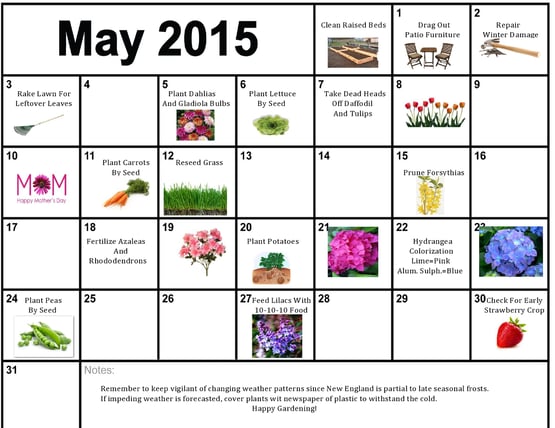
Exotic Flowers in Boston

As temperatures begin to rise here in Boston, gardeners are wondering what the next trends for group plantings will be this summer? Window boxes, raised beds and patio pots are all part of your home’s landscaping design so be sure you are ready to plan an attractive design that properly accentuates your property. Although these creations should show individuality to your tastes, experts have devised a framework to ensure your summer flower’s best performance efforts. For instance, color, texture and size all effect the final presentation of the plants whether they are being hung from an arbor or rooted within a larger garden plot. Other factors that are crucial to measure are the specimen’s longevity throughout the season and ability to acclimate in different weather patterns that we know makes New England gardening sometimes a challenge. As I start to sift through seed catalogues and local nursery websites, I will try to keep these few suggestions in mind in order to build my successful raised garden beds this June.
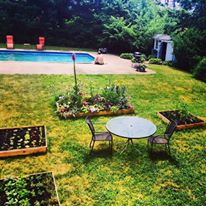
Its not always easy choosing the right flowers suitable to the areas those are available to you. Some varieties prefer moist soil while others desire a drier plot, which makes it crucial for you to read the care instructions before buying anything. Don’t let desire get in the way of your selection process because no matter how much you love a perennial or annual, if you don’t have the proper environment for it to grow, the selection will fail to thrive. In some circumstances you can manipulate the soil such as making wood or plastic draining containers where you can fill it with the proper material that will enable a wider variety of options for you. In this case, its smart to get the opinion of a home improvement specialist or florist to help you decide on the material you’ll need for construction.
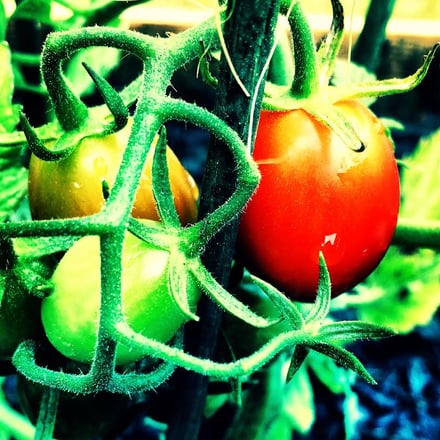
Deciding your color palette is really important to pre-planning gardens because it will aid to avoiding an uncomfortable clash once the plants have been plotted. You don’t want all of that hard work to go to waste on a messy arrangement that will be unattractive in your yard. One way to develop a blueprint is to get out your paints and start trying out different shades and their combinations with others. This will allow a large spectrum of diversity and you’ll be able to match most outcomes with the products your greenhouses will have available. Years ago I met a floral designer who swore that adding white into a brightly mixed assortment of color only worked to separate the flow of the other flowers. His advice was to keep whites in their own plot to ensure a visually stimulating and appealing presentation. Other pros encourage a mass array of dark and light blossoms because it illuminates a spectacular burst of flowers, which is exactly what Mother Nature has offered to all of us!
Suzie Canale
Westwood, MA
Tags: Garden Center, Gardening, Gardening in Boston, #EXFL, herbs, Arbor Day, Earth Day
Doctors say to get outdoors if you want to be healthy and you know what, they’re right! Studies show that an increase amount of time spent walking in the woods, combing sandy beaches or playing on the lawn with your kids can actually help eradicate illnesses, stress and ailments. Believing this to be true, I set up an experiment to see if this actually would help my lack of flexibility and backaches that I had been experiencing. To my surprise, there was no doubt that taking an extra fifteen minutes a day to participate in my favorite outdoor activity actually did wonders for these common problems felt by many. What was that activity you ask? Well, gardening of course! Through a period of six weeks, I not only noticed a clear change but also developed a few tips for others who might be going through the same predicament. Without strenuous positions or exhausting tasks, flexibility in muscles and depletion in upper and lower framework afflictions can be attained by following a few easy suggestions when enjoying a planting session of your favorite begonias.
Before bending down to reach for your flat of plants, take a deep breadth from the diaphragm and release the air slowly from your lungs. It’s sounds strange but professionals reveal that in general, people do not breath enough throughout their day, which can actually cause heightened anxiety and stress. Think of it as your warm up exercise and you’ll notice right away the decrease in tension within your body. Once you’ve done this your ready to fully emerge yourself in the “health” of gardening.
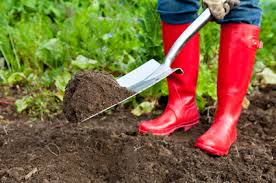
photo credit: globalgardensgifts.com
Next you’ll want to get going with your potting and digging so remember when kneeling to do this very slowly as to avoid pulling or tearing of the joints. When bending for multiple plants, bow at the knees instead of a full frontal curve of the back to the ground. This will ease your way into the motion and give you toning as you repeat this movement throughout your session.
If you aren’t into kneeling by your flowerbeds and you’re not afraid of grass stains, sit your bottom right down on the ground and extend your legs in front of you. While you are preparing the soil, take a second to stretch your arms as far down across your legs as you feel comfortable doing. After you get the hang of this, try folding one leg behind you while still keeping the other leg straight. You will feel a bit of tightening that means that the quad is stretching. Other positions that are helpful for flexibility include laying your hands behind your back and forming an arch or lifting your arms straight above your head for a complete lengthening of shoulders, biceps and triceps.
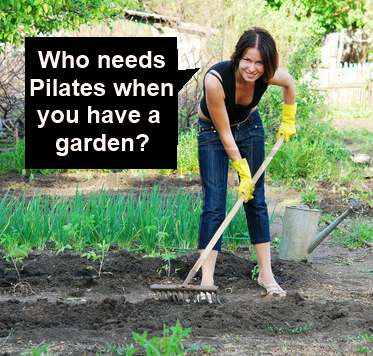
photo via aberdeenflorist.com
Get out there and sample these ways to heighten flexibility and decrease back pain without ever having to leave your backyard. You won’t believe the difference a good gardening day can do for your flowers and your body.
Tags: Gardening, Garden Roses, Gardening in Boston, #EXFL, exercise, Arbor Day, Earth Day
I’m looking at the thermostat hanging on the deck and can’t believe my eyes… It’s almost fifty degrees out in Boson and the sun is shining! The change in weather is calling me to begin organizing my garden tools in the shed and plan my list for what I’ll need at the garden center. Rakes, trowels, mulch and other odds and ends will have to be bought but this year due to all of the snow, I’m going to need to replace a few things in the yard. One fixture that will be at the top of my spring chores is rebuilding the several raised beds that unfortunately couldn’t take the severe winter that just passed. Pre-made box gardens can be extremely expensive and can range in cost anywhere from fifty to several hundred dollars. For me, it’s just not worth the expense so I prefer to pick up a hammer and nail and create them myself.
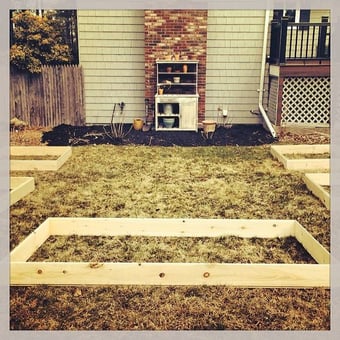
Without becoming anxious about the task, I’ll make sure that I design an accurate blueprint of what supplies will be needed and a clear list of steps for construction so I’m not wasting precious time that I could be spending elsewhere. If you’re like me, you might be in the same predicament but don’t worry. It doesn’t matter if you’ve never been a do-it-yourself kind of a person because there is an easy and affordable method that I’ve found. See if this works for you, too and soon you’ll be planting and weeding before you know it!
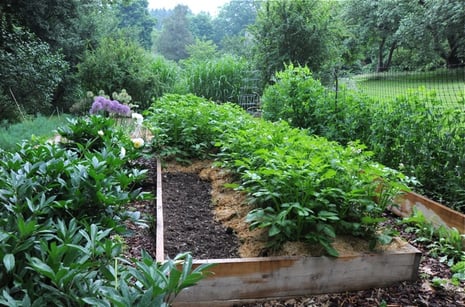
photo credit: awaytogarden.com
Visit a trusted home improvement store in your area and grab a cart to make selection and transportation of the materials simpler. To make one raised bed, find the lumber department and browse the different varieties of wood that are in stock. Depending on your green thumb’s tenacity, pick a length that will suit your needs. My previous boxes measured at eight feet long, which provided ample space for a large variety of flowers and vegetables. The height of the lumber reached six inches that might seem too short but worked well once the soil was added. The width of the wood was cut much shorter than the length, which was half in size at four feet. The rectangular shape was perfect and enabled me to make a pretty pattern with three other boxes erected in a square allowing me to set up a table and chair in the center. Now I bet your asking what type of wood should you buy? Well, there are a lot of options including cedar, oak, pine and reclaimed wood. Keep in mind that the price will fluctuate with the variety you choose so be sure to ask a salesperson what the total will be before you bring them to the register.
Once you’ve bought your wood, take the pieces home and arrange them in the size and shape that you would like the beds to be in. Then take a four-inch nail and attach the corners of the sides in a ninety-degree angle. You will need two nails per corner, one for the top and one for the bottom. Once they have been constructed, place in the location that you want them to be displayed. After they have been filled with soil, you wont be able to move them so choose wisely. The last step is to fill them with an earth friendly soil mix and begin planting!
Suzie Canale
Westwood, MA
Tags: Garden Center, Gardening, Gardening in Boston, #EXFL
Are your pockets bulging from your recent IRS tax returns? Is it burning a whole through your wallets? Are you wondering what to do with this windfall of cash? Unfortunately, that trip to the Keys or shopping spree to the mall might have to hold off until next year…
For homeowners, many of us suffered a pretty hefty handling of damage from this winter’s blizzards and need to do a ton of clean up and repairs to get things back to where they used to be. Gardens and landscaping particularly took a hard hit destroying sheds, pool coverings and recent shrubbery plantings.
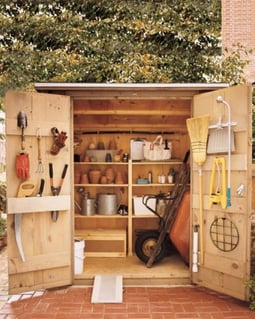
photo credit: marthastewart.com
It’s not as depressing as it sounds, I promise. Purchasing supplies that will rebuild your surrounding property will not only increase its value but also provide a visually appealing oasis for you and your family to enjoy during the summer months.
But where should you start?
The first thing you should do is to take a walk around your house and write down everything that looks like it needs to be replaced. Include broken fences, rotted raised flowerbed wood, tree destruction, shrub decay and lawn tile breakage. Once you’ve got everything listed, go through and mark the estimated cost for repair. Choose one issue that is on the more expensive side and one that is less expensive. That’s where you want to begin buying materials to fix these impairments. If there is something that you know you just can’t wait to see new again, go ahead and put it as the top priority. After all, it is your money!
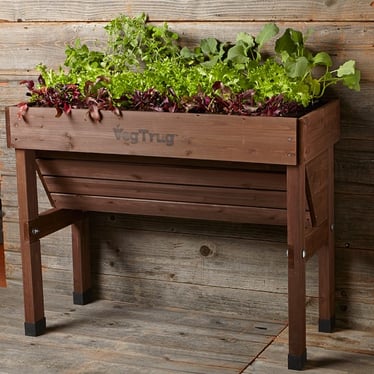
photo credit: williams-sonoma.com
Patio and lawn furniture is unfortunately one of the most commonly replaced summer products for New England homeowners. Although they are supposed to be stored once the snowfall arrives, we sometimes get bogged down with other winter chores and preparations and simply forget to. That’s why its so important to find places in your area that sell second hand tables and chairs for the outdoors so that you don’t have to spend a ton of your tax return replacing the originals. If you don’t have any of these treasure troves located close by, seek out confinement or reparation stores that might carry these items at a bargain price. You’ll love the retro feel and be pleasantly surprised as to the money you’ll save!
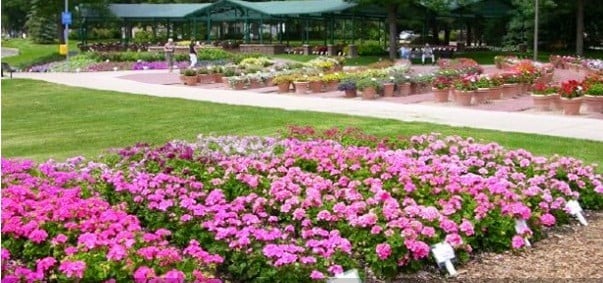
photo credit:Flower Factor
Unfortunately, we’re all going to be replanting many of our favorite perennials this year due to the severity of the ice that Bostonians experienced but that doesn’t mean we have to blow our wad entirely! There are plenty of deals for these blossoming beauties; you just have to find them. Try visiting garden club sales where you can usually pick up stunning clippings from other people’s gardens at a low cost. Lamb’s ear and lady’s mantle in particular are fabulous specimens to be on the lookout for. Don’t forget to drop by local farm stands too because often, they carry samplings from their own harvests and sell them at cheaper prices than larger greenhouses.
Suzie Canale
Westwood, MA
Suzie will be spending the spring at our Westwood home rehabilitating her garden.
Tags: Gardening, Garden Show, Outdoor Living, Spring, Yard Work
So most Boston gardeners are looking out their windows and getting a little depressed by the visions of six foot snow banks still covering their flower beds. I know it’s a bit late in the season for us to be seeing this but really, it’s not so bad at all! Just because the winter precipitation hasn’t said its farewells yet doesn’t mean that we wont have a fabulous summer garden. In actuality, if you look at things in another light, it means just the opposite! Sure, our time will be cut a little short being able to prep and plant but a longer snow fall really does help our green thumbs in the long run. Here’s how…

Snow might seem cold and uncomfortable to us, but to our gardens, a multitude of white snowflakes can act as a warm blanket that works to protecting the root systems from the harsh elements of ice and wind. Perennials and herbs particularly respond well to an increase of accumulation and often aid the plants to grow larger and healthier when the hibernation season finally ends.
Although the snow falls in flaked form, all it really is in warmer climates is water, which we all know is an asset for gardens. You might think that it isn’t possible for the snow to hydrate the plants when its frozen but the slow melting effects become its own watering system that benefits the roots that are lying dormant. Once the snow disappears, gardeners will be thrilled to learn that their gardens have really been watered all throughout the cold season, blooming a better specimen than what you had in the beginning.

If you’ve planted new trees or shrubs this past fall, you’ll be pleased to know that the record breaking snowfall that was recorded helped nurture your landscape additions by anchoring the base to the ground. Many times, a winter with less precipitation and more wind can damage the tree so badly that a replanting is needed the following autumn. Things might look frozen but at least things have stayed intact and well kept together!
The slimy things that crawl beneath the soil are really important to keeping our gardens healthy because they churn the earth and keep things moving with hydration and food. If there isn’t anything to protect these creepy crawlers, then they die with the rest of the garden once the warmer season is over. If there is a warm blanket of snow to protect them, then they can keep on doing what they do best year round!
Suzie Canale, Avid Gardener
Westwood, MA
Tags: Gardening, Hydrangeas, Gardening in Boston, #EXFL
After the Snowpocalypse - What Will Bloom First in Boston
Posted by Suzie Canale on Wed, Mar 25, 2015
So there’s still a lot of snow on the ground but things are starting to heat up around here in Boston! Pretty soon, the gutters will stop leaking, the ice on the driveway will melt and our shovels will be put away until next winter but guess what else will be changing soon? Our gardens! Yes, my fellow New Englanders, I promise you there’s actually life in the works happening right below those last few feet of blanketed snow. You may be looking out your window in disbelief, but it’s a fact that a snowy winter can actually be beneficial to our flower and vegetable beds. This is because the snow acts as a warm cover and becomes its own watering system long after the fruit and blossoms have reaped their seasonal harvest. Herb gardens can do particularly well within this case, benefiting varieties such as rosemary, sage and thyme. New plantings of basil and some types of parsley can be expected, but all in all your herbs will thank old man winter for his snow fury. So what should we expect to see bloom first in our backyards after the clean up has occurred? Here are some beauties to look forward to until spring officially arrives…
Crocuses
Crocuses are probably the number one flower that appears first in most New England gardens. Originating from the iris family, crocuses bloom from what are called “Corms”. The ability for the heads to extend through colder weather and even snow make this a desirable plant for garden lovers as well as their beautiful colors that include purple, violet, yellow, white and even striped. Another bonus of including crocus in your plantings is that they are very hard to kill and will spread and multiply over time.
Tulips
If you haven’t planted tulips in your yards quite yet, here are a few reasons to get you motivated. Grown from a bulb, Boston soil is ideal for cultivation because they love cold winters and dry summers, which holds common to this area. Native to southern Russia, these beauties are ultimately bred in almost every color imaginable including black, blue and multi-colored. A tulip head can have one or double petals surrounding its center often resembling a stunning silk cocoon. The perennials are perfect as edging for garden borders or placed in clumps to present a beautiful floral display. One thing to be mindful of if you live near a wooded forest area, deer absolutely love to eat this perennial and will chew the heads clean off if not guarded by a gate.

Hyacinth
Hyacinth is another spring season starter, arriving soon after the crocus and right before the tulips. The plant is tied to Greek mythology believed to hold the blood of one of Apollo’s victims killed in battle. The shape of the hyacinth resembles a skinny beehive with several bell-like buds that run up and down the thick stem. Available in shades of pink, white, lavender, yellow and dark blue, the flashy bulbed plants possess a sweet smell that will fragrant your home or garden. Cuttings are remarkably durable so don’t forget to utilize hyacinth in spring bouquets and centerpieces!Suzie Canale
Westwood MA
she had hundreds of bulbs to her home in Westwood every year.
Tags: Gardening, Gardening in Boston, Tulips, Hyacinth, bulbs
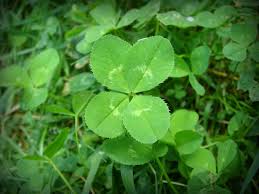
Saint Patrick’s Day is almost here and Bostonians are getting ready to celebrate by taking time to partake in some of the traditional activities associated with the holiday. Sure we all will be wearing green and cooking our corn beef and cabbage meals but how about finding a little luck to go along with our plans this year? One of the greatest customs associated with March 17th is the possibility of discovering your dreams and wishes through a little luck! For some it is a pot of gold at the end of a rainbow or catching a sneaky Leprechaun but for many, these tasks seem a bit too trying. So how about something a bit more simple like finding a four-leaf clover? Many believe that this is an impossible chore but in reality, four-leaf clovers are produced 1 in every 10,000 clovers. The fourth leaf stems from a mutation of the plant where it is actually the first clover of a whole other specimen. Now those odds don’t seem so bad do they? You will also be surprised as to the number of suggestions experts have made to pin point probable locations that will help your search be more successful. These are a few tips to get your investigations started and hears to finding a little bit of luck this Saint Patrick’s Day!

Hot Tips
- Once the snow melts and the spring warms the earth once again, find a patch of lawn or visit a local park where there is an abundance of greenery in the area. Seasonally, clove hunting extends through March all the way to August. Great spots include baseball fields, backyards and even rocky topography, which ironically produces healthy clover.
- Stand upright over a large mass of clover and scan the area. Do not bend down to look. You will have a better chance from viewing and locating while standing erect and not crouched down. Lightly brush your foot across the patch, gently separating the clumps so that the plants are flat.
- Peer down to the clover and look for the patterns in the leaves and you will begin to notice how fast sets of threes will stand out from any sets of fours.
- Do not get discouraged if you have trouble at the start, your eyes will eventually adjust and pretty soon you will be picking your four-leaf clovers. Be mindful that there may be several in one area because commonly, they grow efficiently with one another. You should also know that there is accounts of five to eighteen clover samples in the wild so don’t limit yourself to only finding four!
Tags: Gardening, Holidays, Saint Patricks Day
by Suzie Canale
Westwood, MA

The colder temperatures are slowly but surely creeping in and many New Englanders are becoming anxious about the demise of their hard worked summer gardens. Although Mother Nature’s reclaims our green thumb’s efforts during the colder months of the year, there are ways to enjoy some of our hardier favorites year round by learning the techniques of indoor plant weathering. While it is true that not every growth can be repotted and stored until the thaw of spring arrives, there are some varieties, which make perfect candidates for building an indoor winterized garden. Unfortunately, due to this region’s inclement drop in temperature, not every garden favorite will be strong enough to make the transition from your Boston back yard, so before taking your trowel to begin digging, keep these tips in mind to make sure you are choosing the right species. By keeping your eyes peeled for these hardier varieties, you’ll have a fighting chance of keeping some of your favorite greenhouse treasures year round.

Many herb plants are wonderful for re-planting once the autumn frosts have begun. Types such as parsley, sage and particularly rosemary are easily transitioned from the garden to a sunny windowsill and require very little maintenance with the exception of a once a week watering and pruning when stems become spindly and brittle. Basil is a highly desired herb for transfer but often has disappointing results since the plant prefers warm temperatures and a significant amount of light to thrive. Commonly, the plants will stay the same size when brought inside until replanted back into their natural environment so the constant need for larger planting containers is rarely an issue. When removing the roots from the outside soil, make sure you dig far enough down to get the entire system (or as much as possible) to avoid damaging the plant and causing a stressful transfer. Once safely inside, locate a sunny area with little drafting. An icy spot can cause an instant droop within the petals and a shorter likelihood of survival.
Several people desire a flowering plant to enjoy within their Boston home once their gardens have gone to sleep for the winter. Truthfully, it’s a difficult order to fill but not impossible if you choose the right selection. Scented and unscented geraniums make excellent candidates and seem to thrive both indoors and outdoors if properly cared for. Be mindful of areas with a lot of sunlight for placement, a weekly watering schedule and the occasional task of removing dead leaves and unhealthy stems. Plant food should also be put into the mix every few weeks to ensure an adequate amount of nutrients. Another flowering possibility is marigolds, which seems to also transition easily from one place to the next. More durable than some of your other garden varieties, these pretty little blooms will provide a cheerful burst of color and appealing scent with little maintenance required. Winter is just around the corner, so pick out your favorites and start building an indoor garden that will keep you entertained until the warmth of the summer returns once again.
 Suzie Canale is the Founder and President of The Women's Lockerroom Foundation, has written four children books, works at the Westwood Public Library and raises two sons.
Suzie Canale is the Founder and President of The Women's Lockerroom Foundation, has written four children books, works at the Westwood Public Library and raises two sons.
Tags: Gardening, Gardening in Boston, Plant Care, Suzie Hearl Canale, Author, Suzie Canale
The Best USA Flag Ever That Does Not Fly is Made of Flowers
Posted by Rick Canale on Thu, Aug 02, 2012

Tags: Gardening, Veterans Day, USA, 9/11, July 4th

